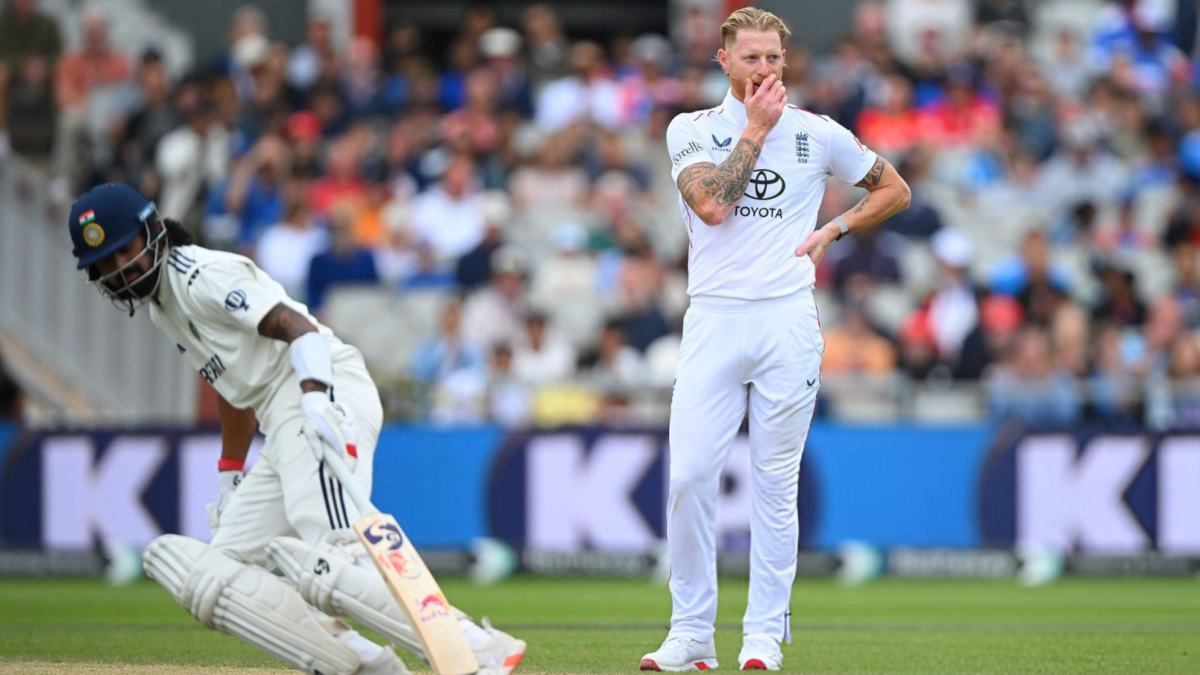
This time, Bazball has its real competitor.

You could feel that frustration creeping in among English players during the second session of the final day in Manchester. Ben Stokes threw everything he had in his arsenal, including himself, but nothing could affect Ravindra Jadeja and Washington Sundar. Then came the nadir, when an hour was left, and all that England had left were sore bodies and drained minds.
That whole handshake saga encapsulated the series’ narrative until that moment. England are ahead in the series, and in the end, that’s the line that counts. But India have pushed them at every step, frustrated them in every game.
Since the Bazball era, England have made Tests quicker on every metric. They bat quickly and sometimes make premature declarations, try bowling more magic balls with a set of bowlers designed for errors, and chop and change too many fielding positions on almost every ball in an attempt to force rapid results. To their credit, things have often worked.
So, they were right to continue it against India, a team missing two veteran batters and having a bowling lineup with certain flaws and limited experience. But India cracked the code early in the series. From the first Test, the team’s conscious effort has been to keep England on the field for as long as possible.
ALSO READ:
England have bowled 894.2 overs in four matches of the Anderson-Tendulkar Trophy, already the second-most in a series in the Bazball era. For context, they delivered 898.1 overs across five games in the Ashes 2023 and away India series in 2024, only four more with one extra Test. India could have surpassed the figure already had they decided to continue tormenting the home side in Manchester.
At Old Trafford, England bowled 250+ overs in a home Test for the first time in the Bazball era. 3 of the five home matches with the most overs bowled have come in this rubber only. Their bowling average of 44.89 is the worst they have ever had in a series since Stokes took over.
All four matches have run until Day 5, three of them dragging into the final session. India’s fairly inexperienced and shaky batting unit might be one of the reasons to churn out flat decks in every game. India arrived on England’s shores with one of their weakest batting lineups ever.
They had Shubman Gill, with three Tests in England and a captaincy burden, Sai Sudharsan, yet to make his Test debut, Yashasvi Jaiswal, playing his maiden England series, Karun Nair, returning to the side after eight years, and Washington Sundar and Nitish Kumar Reddy, with no prior experience of the conditions. Then, there was KL Rahul, who averaged 34.11 in England before this series and was still figuring out his way to be consistent. India’s bowling threat was also manageable on flat pitches.
But when it didn’t pan out as expected, that’s when the frustration began. England bowlers have had to bowl long spells for every wicket, partnerships kept sprouting after early scalps, and even tailenders showed resistance beyond expectations at one point. The flat surfaces have negated England’s own bowling strength.
For instance, Josh Tongue bowled unplayable deliveries at times but was wayward most of the time. Chris Woakes’ effectiveness at home diminished on flat pitches, Brydon Carse bowled well with no rewards since the surface offered enough leniency on false shots, while Ben Stokes has to break his body with marathon spells in almost every game. Then came Jofra Archer, who was brilliant at Lord’s but slowly tapered off by the second innings in Manchester due to the nature of the pitch.
There might also be frustration with the opponent spinners outbowl their counterparts even on these surfaces, and then the same spinners score centuries to save a Test match. There was a reason why England didn’t declare even after England had a substantial first-innings lead in Manchester and kept batting even after Stokes was dismissed. They wanted to make so much that India’s win becomes completely improbable.
That’s the kind of impact India have had in this series; they have sown enough doubts in England’s minds to make them rethink their strategy that has reaped rewards lately. Despite two Tests going their way, England haven’t really had a real edge over India at any stage. The victories came, but not in the dominant way they wanted, and a few calls here and there could have put England in India’s position.
When Harry Brook was confident enough to chase even 450, India threw the same challenge by asking them to chase 608 in the final innings at Edgbaston. England, who always claim not to play for a draw, were forced to shake hands with an hour to go. India have drained the opponent’s bowling attack so much that Stokes will need fresh legs at The Oval.
Even their spinner, Liam Dawson, playing his first Test in the series, sustained a niggle by the end of his spell. Brook and Joe Root’s use in the final few overs depicted the frustration and helplessness, a sense that England had given up. India literally beat the fight out of England.
This time, Bazball has its real competitor. More than that, India have found the best way to break the whole thing – bat and bat so much that this flawed England side starts to wear down. While this was always their breaking point, no other team managed to do so in the last three years.
Even Australia, with a better and more experienced batting and bowling attacks, couldn’t break them to this point in the Ashes 2023. That’s where India have won, mentally. That’s the real moral victory, if one indeed exists.
For more updates, follow CricXtasy on Facebook, Instagram, Twitter, Telegram, and YouTube.